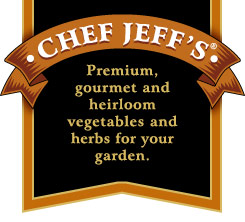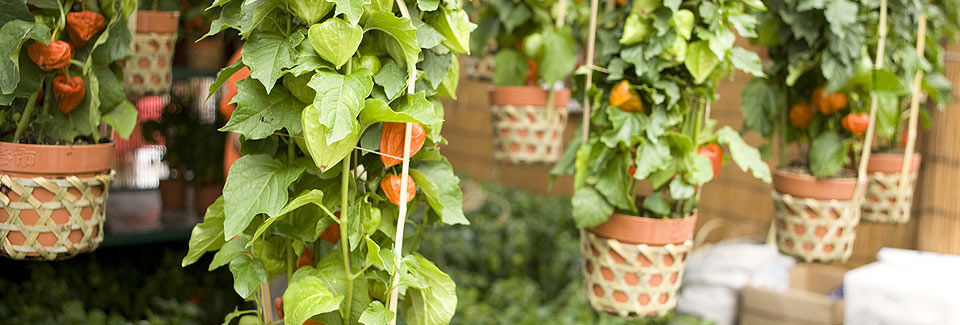Are you limited on space, do want to garden on your balcony? Would you like to have some fresh veggies and herbs right next to your kitchen door? Container gardening will fill your needs and can be very rewarding at harvest time!
SELECT COMPACT PLANTS
Bush–type plants are better suited for limited space available when container gardening. Here are some Chef Jeff vegetables available in bush form:
- Beans – Bush Blue Lake and Black Wax Pencil Pod
- Tomatoes (Determinates) – Roma Plum, Yellow Plum, Tomato 444, Bradley Pink, Carnival, Chello, Patio, Tomato Health Kick, Marglobe, and Rutger’s Select
- Cucumbers – Bush Pickle
- Squash – Peter Pan and Aristocrat Zucchini
Variety is the spice of life. Use a mix of veggies and herbs in your containers. Pot up a salsa garden with tomatoes, hot peppers, cilantro, oregano, onions, chives, and garlic. What could be fresher, tastier and healthier than veggies and herbs you just harvested from your container garden!
SELECT LOW PROFILE PLANTERS
A short, wide container provides more room for root growth, and is less prone to tipping over in high winds. When planting tomatoes or other veggies the container size should be a minimum of 14 inches wide and deep.
- Wooden barrels (retains moisture better than terra-cotta)
- Terra-cotta (readily available, less prone to tipping over due to weight, require extra watering)
- Ultra-lite resin pots (more expensive, but easier to move due to light construction – verify it’s food grade plastic, safe for growing veggies and herbs)
- Plastic containers (make sure the container has good drainage and is large enough)
Make sure not to over plant your container. Proper spacing is important for air circulation which minimizes fungal problems.
Regardless of the container you choose, good drainage is essential to prevent root rot. You may need to drill extra holes in your containers. Coaster wheel supports can be added. They allow you to move your containers to maximize sunlight or to shelter during a storm.
LOCATION, LOCATION, LOCATION
Provide plenty (6-8 hours) of sun.
Rotate the containers regularly (every 3 days) to ensure strong, straight stems. Plants reaching for light tend to be weaker and more prone to breakage. Coaster wheel supports are extremely helpful for rotating large and heavy planters.
DIRT, SOIL, WHO CARES?
Do not re-use potting mixtures from year to year. Old potting soil may contain insects or disease pathogens, so start with a fresh potting mix! Make sure to sanitize used plastic and terra-cotta containers with 1 part bleach to 8 parts hot water solution.
Never use garden or top soil in containers, it’s too dense, won’t allow air to the roots and it will become water- logged. There are many good organic/natural potting soils on the market that have an adjusted pH as well as compost and other organic amendments in the mix.
Don’t skimp on potting soil. Cheaper mixes can cause:
- Soggy soil and root rot
- Extremely dry soil
- Weeds and diseases
- Poor nutrient absorption due to unadjusted pH
Add a balanced tomato or vegetable fertilizer per instruction. Maintain a fertilizer program, container veggies require a good amount of food to live up to their full potential. Foliar feeding helps plants in containers immensely. (See Fertilizers)
Make sure to add a Calcium supplement when planting tomatoes and other members of the Nightshade family or zucchini to prevent Blossom End Rot. (See Fertilizers) Additional applications of liquid Calcium sprays may be necessary.
Use gravel, broken flower pot pieces, bark mulch or horticultural charcoal in the pot of the pots to add weight and help with drainage. A coffee filter or piece of landscape fabric placed over the drain holes will prevent soil loss.
Keep up a watering routine. The biggest killer of container plants is over- watering. Moisture meters are a great aid to beginner gardeners. Simply place the probe into the soil, look at the display for a reading. Moisture meters come with recommendations on a particular plant’s watering needs.
Supply a support for climbing veggies like cucumbers and beans. Bamboo teepees work. Many attractive pyramid shaped arbors are available commercially. Tomatoes and peppers will require support when they set fruit. Install supports before the plant bears fruit, they’ll be easier to put on and you won’t knock fruits off in the process!
Statuary and garden art can make a container garden very attractive. There is no limit to what you can plant in a container! Add some edible flowers like pansies or nasturtiums for extra color.
Container gardens are easy to maintain and can reward you with a bounty of produce and herbs!




